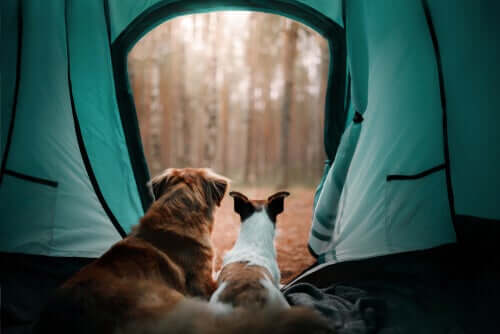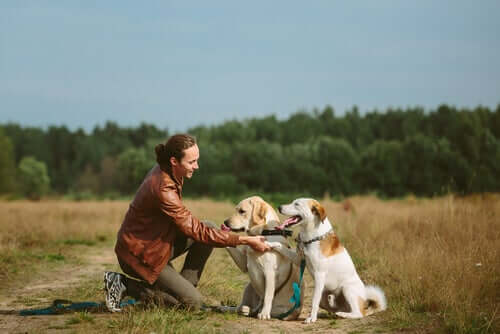Camping with Dogs and Children - Legal Aspects


Written and verified by the lawyer Francisco María García
Camping with dogs and children is a great family activity. Doing so is a great way for you and your pets to experience new sights and smells, get some exercise, and spend time together.
Outdoor activities can definitely be fun for you and your family. But before you go, be aware of the rules and responsibilities, and of the extra steps of preparation that come along with it. Make sure your children know them too before letting them go on their own camping adventures along with their furry pals.
Legal aspects of camping with dogs

Camping is a great way to help children become autonomous and gain some useful outdoor skills. These are important in an era when most of us live in urban areas and digital interaction is the order of the day. These outings may be one of the few opportunities we have to come into contact with nature and expose our children and pets to it.
As a visitor to a national park, you’re responsible for your own safety. Please remember to:
- Plan for your park visit, as careful planning will prevent many safety issues.
- Research and learn about possible risks with the park environment and your camping trip before you go.
- Seek and listen to the information, advice, and warnings provided by park staff.
- Know your physical and mental limits.
- Take action by using good judgment, along with selecting the right equipment and supplies, to prevent any injuries during your visit.
Conditions
Depending on where you camp, you may be able to talk to a park ranger or a campsite host. They’ll likely have current information about the park’s outdoor conditions, regulations, and possible alerts. Be sure to ask the ranger or host about these topics:
- Environmental hazards. For example, are there any rock falls, fire, wildlife, high water in streams from recent rainfall events, or other conditions to be aware of?
- Weather. Is there any rain, wind, snow, or extreme temperatures forecast that could affect your planned activity? You can also check the local newspaper, weather-related website, or radio station for the weather report.
- Park Regulations. Does the park have rules about open fires? Depending on the park, season, and climate conditions, fire bans may be in effect. Also, ask about the proper disposal of food and other trash. Many parks require the use of food storage containers to keep wildlife out of the campground.
Camping with dogs and children – practical and legal issues

- You know your pets better than anyone else. Thus, if you think camping may pose a danger or threat to you or other campers, then you’ll have to leave them at home.
- Find out in advance if the campsite allows pets. This is because some parks could have restricted areas such as park facilities, lakes, ponds, creeks, and streams, etc.
- Are your pets and children in good health? Are they in good enough shape to meet the physical demands of the trip? If they have trouble with longer walks and your camping spot requires a hike to get to, you might want to rethink your plan.
- Be sure your furry friend is up-to-date on all required vaccinations and protected against heartworm, fleas, and ticks. Dogs can encounter a variety of wild animals while camping, even if they are on a leash.
- Outfit your pet with the right collar and ID tags. Your dog should always be leashed at a campsite, but make sure they have a chance at getting back to you if they wander off and get lost. Make sure the collar with ID tags are securely fastened to your dog at all times. Even the best-behaved dogs can slip out of a loose collar and take off after a wild animal when they become too excited. Microchipping and registering your dog is an added measure you can take to ensure someone can contact you if they find them.
- Many parks don’t allow pets on hiking trails or boardwalks. So, always check park regulations if you plan on hiking during your stay. Ask your park ranger for some tips on hiking with your pets and children.
The proper preparation and training of the dog
- It might seem obvious, but don’t forget to pack food, water, and bowls for your animal. Find light or collapsible bowls as these take up less space and are easier to carry. Bring extra food if you’ll be doing any strenuous activity. Like you, your pet will be hungry after exerting extra energy.
- Bring along a retractable leash as is a great way to allow your dog to explore the campsite while you relax knowing they’ll stay in the area. Many parks won’t allow you to tie it to a tree, so bring a stake to put in the ground. Most campsites have a 6 ft leash policy, but check your park for specific rules.
- Bring a First aid kit so you’re prepared for the minor accidents.
- Don’t forget to bring poop bags to pick up after your pet.
- You’ll probably need at least one towel to line your car or tent and/or to wipe off your dog.
- Be mindful of restricted areas.
- And, be courteous to other campers by picking up after your dog and controlling their barking.
- Never leave your dog unattended, especially inside a hot vehicle.
As an adult, you’re responsible for preparing your dogs and children in advance. So, teach them how to behave on a camping trip. Enjoy yours!
Camping with dogs and children is a great family activity. Doing so is a great way for you and your pets to experience new sights and smells, get some exercise, and spend time together.
Outdoor activities can definitely be fun for you and your family. But before you go, be aware of the rules and responsibilities, and of the extra steps of preparation that come along with it. Make sure your children know them too before letting them go on their own camping adventures along with their furry pals.
Legal aspects of camping with dogs

Camping is a great way to help children become autonomous and gain some useful outdoor skills. These are important in an era when most of us live in urban areas and digital interaction is the order of the day. These outings may be one of the few opportunities we have to come into contact with nature and expose our children and pets to it.
As a visitor to a national park, you’re responsible for your own safety. Please remember to:
- Plan for your park visit, as careful planning will prevent many safety issues.
- Research and learn about possible risks with the park environment and your camping trip before you go.
- Seek and listen to the information, advice, and warnings provided by park staff.
- Know your physical and mental limits.
- Take action by using good judgment, along with selecting the right equipment and supplies, to prevent any injuries during your visit.
Conditions
Depending on where you camp, you may be able to talk to a park ranger or a campsite host. They’ll likely have current information about the park’s outdoor conditions, regulations, and possible alerts. Be sure to ask the ranger or host about these topics:
- Environmental hazards. For example, are there any rock falls, fire, wildlife, high water in streams from recent rainfall events, or other conditions to be aware of?
- Weather. Is there any rain, wind, snow, or extreme temperatures forecast that could affect your planned activity? You can also check the local newspaper, weather-related website, or radio station for the weather report.
- Park Regulations. Does the park have rules about open fires? Depending on the park, season, and climate conditions, fire bans may be in effect. Also, ask about the proper disposal of food and other trash. Many parks require the use of food storage containers to keep wildlife out of the campground.
Camping with dogs and children – practical and legal issues

- You know your pets better than anyone else. Thus, if you think camping may pose a danger or threat to you or other campers, then you’ll have to leave them at home.
- Find out in advance if the campsite allows pets. This is because some parks could have restricted areas such as park facilities, lakes, ponds, creeks, and streams, etc.
- Are your pets and children in good health? Are they in good enough shape to meet the physical demands of the trip? If they have trouble with longer walks and your camping spot requires a hike to get to, you might want to rethink your plan.
- Be sure your furry friend is up-to-date on all required vaccinations and protected against heartworm, fleas, and ticks. Dogs can encounter a variety of wild animals while camping, even if they are on a leash.
- Outfit your pet with the right collar and ID tags. Your dog should always be leashed at a campsite, but make sure they have a chance at getting back to you if they wander off and get lost. Make sure the collar with ID tags are securely fastened to your dog at all times. Even the best-behaved dogs can slip out of a loose collar and take off after a wild animal when they become too excited. Microchipping and registering your dog is an added measure you can take to ensure someone can contact you if they find them.
- Many parks don’t allow pets on hiking trails or boardwalks. So, always check park regulations if you plan on hiking during your stay. Ask your park ranger for some tips on hiking with your pets and children.
The proper preparation and training of the dog
- It might seem obvious, but don’t forget to pack food, water, and bowls for your animal. Find light or collapsible bowls as these take up less space and are easier to carry. Bring extra food if you’ll be doing any strenuous activity. Like you, your pet will be hungry after exerting extra energy.
- Bring along a retractable leash as is a great way to allow your dog to explore the campsite while you relax knowing they’ll stay in the area. Many parks won’t allow you to tie it to a tree, so bring a stake to put in the ground. Most campsites have a 6 ft leash policy, but check your park for specific rules.
- Bring a First aid kit so you’re prepared for the minor accidents.
- Don’t forget to bring poop bags to pick up after your pet.
- You’ll probably need at least one towel to line your car or tent and/or to wipe off your dog.
- Be mindful of restricted areas.
- And, be courteous to other campers by picking up after your dog and controlling their barking.
- Never leave your dog unattended, especially inside a hot vehicle.
As an adult, you’re responsible for preparing your dogs and children in advance. So, teach them how to behave on a camping trip. Enjoy yours!
All cited sources were thoroughly reviewed by our team to ensure their quality, reliability, currency, and validity. The bibliography of this article was considered reliable and of academic or scientific accuracy.
- Fanneth Flórez Fernández. La influencia positiva de los animales en los niños. 2008. Extraído de: http://biblioteca.usbbog.edu.co:8080/Biblioteca/BDigital/42081.pdf
- Revista colombiana de ciencias pecuarias. 2007. La influencia de las mascotas en la vida humana. Extraído de: http://www.scielo.org.co/pdf/rccp/v20n3/v20n3a16.pdf
This text is provided for informational purposes only and does not replace consultation with a professional. If in doubt, consult your specialist.








